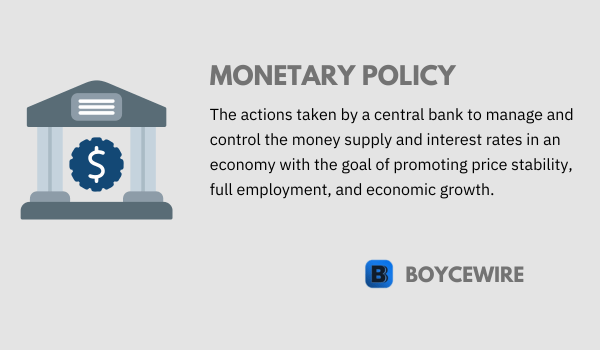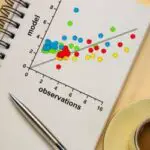Table of Contents ![]()
Monetary Policy: Definition, Tools & Objectives

What is Monetary Policy?
Monetary policy refers to the actions taken by a central bank, such as the Federal Reserve in the United States, to manage and control the money supply and interest rates in an economy.
The primary goals of monetary policy are typically to promote price stability, full employment, and economic growth. Central banks use a variety of tools, including adjusting interest rates, open market operations, and reserve requirements, to influence the level of economic activity in the economy.
By controlling the availability of money and the cost of borrowing, monetary policy can affect the behavior of consumers and businesses, which in turn can impact economic growth, inflation, and employment.
Key Points
- Central banks, like the Federal Reserve in the US or the European Central Bank in the Eurozone, are the institutions responsible for implementing monetary policy.
- Central banks have various tools at their disposal to manage the money supply and influence interest rates, including open market operations, setting reserve requirements, and adjusting the discount rate.
- Central banks buy and sell government bonds in the open market to increase or decrease the money supply. Buying bonds injects money into the economy, while selling bonds reduces the money supply.
- Central banks may require commercial banks to hold a certain percentage of their deposits as reserves, which can impact the amount of money available for lending and thus influence the money supply.
Tools of Monetary Policy
Monetary policy tools are the instruments used by central banks to manage a country’s money supply, control inflation, and achieve other macroeconomic objectives. The primary monetary policy tools include:
1. Open Market Operations (OMO)
Central banks conduct open market operations by buying or selling government securities in the open market. When a central bank buys securities, it injects money into the economy, increasing the money supply and lowering interest rates. Conversely, selling securities reduces the money supply and raises interest rates.
2. Reserve Requirements
Central banks may impose reserve requirements on commercial banks, which mandate that a certain percentage of their deposits be held as reserves. Higher reserve requirements reduce the amount of money available for lending, decreasing the money supply and potentially raising interest rates. Lower reserve requirements have the opposite effect.
3. Discount Rate
The discount rate is the interest rate at which a central bank lends money to commercial banks. By changing the discount rate, central banks can influence borrowing costs and the money supply. A lower discount rate encourages borrowing, increasing the money supply and potentially lowering interest rates, while a higher discount rate discourages borrowing, decreasing the money supply and potentially raising interest rates.
4. Interest Rate Targeting
Some central banks set a target for short-term interest rates, such as the federal funds rate in the US or the refinancing rate in the Eurozone. Central banks use their other policy tools, like open market operations, to influence these short-term interest rates and achieve their monetary policy objectives.
5. Forward Guidance
Central banks may provide guidance on the future path of monetary policy, which can influence expectations and behavior in financial markets. Forward guidance can take the form of qualitative statements or quantitative targets related to economic variables, such as inflation or unemployment.
6. Quantitative Easing (QE)
When conventional monetary policy tools are insufficient or ineffective, central banks may resort to quantitative easing. QE involves the large-scale purchase of assets, such as government bonds and mortgage-backed securities, to inject money into the economy and lower long-term interest rates.
7. Negative Interest Rate Policy (NIRP)
In some situations, central banks may implement negative interest rate policies to stimulate economic growth. This involves setting a negative policy rate, effectively charging commercial banks for holding excess reserves. The aim is to encourage banks to lend more, thereby increasing the money supply and lowering borrowing costs.
8. Credit Easing
Credit easing focuses on improving the functioning of specific credit markets, such as corporate bonds or commercial paper markets. Central banks may purchase private sector assets or provide targeted lending facilities to support the flow of credit to businesses and households.
Objectives of Monetary Policy
The objectives of monetary policy vary across countries and time, depending on the priorities of the central bank and the specific economic context. However, there are several common objectives that monetary policy typically aims to achieve:
1. Price Stability
One of the primary objectives of monetary policy is to maintain price stability, which refers to a low and stable rate of inflation. Stable prices are essential for fostering economic growth and maintaining public confidence in the currency. Many central banks have an explicit inflation target, often around 2%, to guide their policy actions.
2. Full Employment
Monetary policy seeks to promote full employment or minimize unemployment within an economy. By influencing interest rates and the money supply, central banks can impact the level of economic activity and job creation. In some countries, like the United States, the central bank has a dual mandate to promote both price stability and maximum employment.
3. Economic Growth
Monetary policy aims to support sustainable economic growth by providing a stable macroeconomic environment. By managing inflation and promoting full employment, central banks can create conditions conducive to investment, innovation, and productivity growth.
4. Financial Stability
Monetary policy can play a role in promoting financial stability by addressing imbalances in the financial system, such as excessive credit growth or asset price bubbles. In recent years, the importance of financial stability as an objective of monetary policy has grown due to the lessons learned from the global financial crisis.
5. Exchange Rate Stability
Central banks may use monetary policy tools to manage their country’s exchange rate and ensure its stability. Exchange rate stability can help promote international trade, investment, and overall macroeconomic stability.
6. Balance of Payments Stability
Monetary policy can help maintain balance of payments stability by managing the money supply, interest rates, and exchange rates, which can influence a country’s imports, exports, and capital flows.
7. Income Distribution
Although not a primary objective, monetary policy can indirectly influence income distribution by affecting the overall economic environment, inflation, and employment opportunities.
Fiscal vs Monetary Policy
Fiscal policy and monetary policy are two key macroeconomic tools used by governments and central banks to manage a country’s economy. While both aim to influence economic activity, they differ in terms of their objectives, tools, and the institutions responsible for implementing them.
Fiscal Policy
- Objectives Fiscal policy primarily aims to influence the level of aggregate demand in the economy to achieve macroeconomic objectives such as economic growth, full employment, and income redistribution.
- Tools Fiscal policy involves changes in government spending, taxation, and borrowing. By adjusting these components, governments can stimulate or slow down economic activity. For example, increasing government spending or cutting taxes can boost aggregate demand, while reducing government spending or raising taxes can have the opposite effect.
- Responsible Institution Fiscal policy is typically formulated and implemented by the government, including legislative bodies and finance ministries. Fiscal policy decisions are often subject to political considerations and public debate.
Monetary Policy
- Objectives Monetary policy primarily aims to maintain price stability and support economic growth by managing the money supply, interest rates, and credit conditions. Some central banks also have objectives related to employment and financial stability.
- Tools Monetary policy tools include open market operations, reserve requirements, discount rate adjustments, interest rate targeting, quantitative easing, and forward guidance, among others. Central banks use these tools to influence interest rates, the money supply, and credit availability, which in turn affect investment, consumption, and overall economic activity.
- Responsible Institution Monetary policy is formulated and implemented by central banks, such as the Federal Reserve in the US or the European Central Bank in the Eurozone. Central banks typically operate independently from the government to ensure policy credibility and effectiveness, although they may coordinate with the government in times of crisis.
In summary, fiscal policy focuses on government spending, taxation, and borrowing to influence aggregate demand, while monetary policy involves managing the money supply and interest rates to maintain price stability and support economic growth. Both policies play crucial roles in managing a country’s economy, and effective coordination between fiscal and monetary authorities is essential for achieving macroeconomic goals.
FAQs
Monetary policy refers to the actions taken by a central bank or monetary authority to manage a country’s money supply, control inflation, and achieve specific macroeconomic goals such as price stability, full employment, and economic growth.
Central banks, such as the Federal Reserve in the US or the European Central Bank in the Eurozone, are responsible for implementing monetary policy.
The primary monetary policy tools include open market operations, reserve requirements, discount rate adjustments, interest rate targeting, forward guidance, quantitative easing, and, in some cases, negative interest rate policy and credit easing.
Expansionary monetary policy involves actions that increase the money supply, lower interest rates, and stimulate economic growth, such as purchasing government bonds, lowering reserve requirements, or reducing the discount rate. Contractionary monetary policy involves actions that decrease the money supply, raise interest rates, and slow down economic growth to curb inflation, such as selling government bonds, raising reserve requirements, or increasing the discount rate.
Monetary policy can impact inflation by influencing the money supply, interest rates, and credit conditions. For example, an expansionary monetary policy can increase the money supply, lower interest rates, and encourage borrowing and spending, which can lead to higher inflation. Conversely, a contractionary monetary policy can decrease the money supply, raise interest rates, and discourage borrowing and spending, which can help reduce inflation.
About Paul
Paul Boyce is an economics editor with over 10 years experience in the industry. Currently working as a consultant within the financial services sector, Paul is the CEO and chief editor of BoyceWire. He has written publications for FEE, the Mises Institute, and many others.

Further Reading
 Correlation Coefficient - The correlation coefficient is a statistical measure that quantifies the strength and direction of the linear relationship between two variables.
Correlation Coefficient - The correlation coefficient is a statistical measure that quantifies the strength and direction of the linear relationship between two variables.  Gross National Income Definition - GNI, or Gross National Income, is the total value of goods and services produced by a country's residents, including income…
Gross National Income Definition - GNI, or Gross National Income, is the total value of goods and services produced by a country's residents, including income…  Expansionary Monetary Policy - Expansionary monetary policy is an economic approach where central banks increase the money supply, lower interest rates, and employ other…
Expansionary Monetary Policy - Expansionary monetary policy is an economic approach where central banks increase the money supply, lower interest rates, and employ other… 